What is Wild Running?
Wild Running Q&As So what is wild running exactly? For us, wild running falls somewhere between,…
This 55 mile winter ultra run will test all your abilities as both your mind and body are placed under stress in this unforgiving environment.
cheviotgoat.com
I first heard about the Montane Cheviot Goat ultramarathon back in 2017. At the time a trip to Northumberland in December seemed like an unlikely prospect. But when the opportunity to race AND test out some of Montane’s excellent kit came along it was too good to turn down. Cue a rapid reshuffling of our family Christmas arrangements to include a festive week near the beach in Bamburgh and I was good to go.
Registering in the tiny village of Ingram at 5am on December 7th I presented my emergency kit for checking, trying not to hear as the chap next to me told the marshall how he had needed it last year. Race number and gps tracker attached I joined about 300 other runners for the briefing. Although the weather didn’t look too bad, high winds were forecast for the evening so the decision had been made to run the route in reverse. This meant we’d be off the highest and most exposed sections before the worst weather hit. While this late change played a few mind games I was pretty happy overall as it meant the toughest climb and worst bogs would be in the first half, leaving the slightly easier terrain for the end. I made a few last minute kit changes to reflect the switched course and headed for the start.

The first few pre-dawn miles were fun, settling into a rhythm and waiting for the sunrise. I was still enjoying myself on the long climb up Dunmoor Hill and being able to look ahead and back at the line of head torches was magical. My legs felt good, my training had gone well and I’m strong on rough ground so I was in a good place.
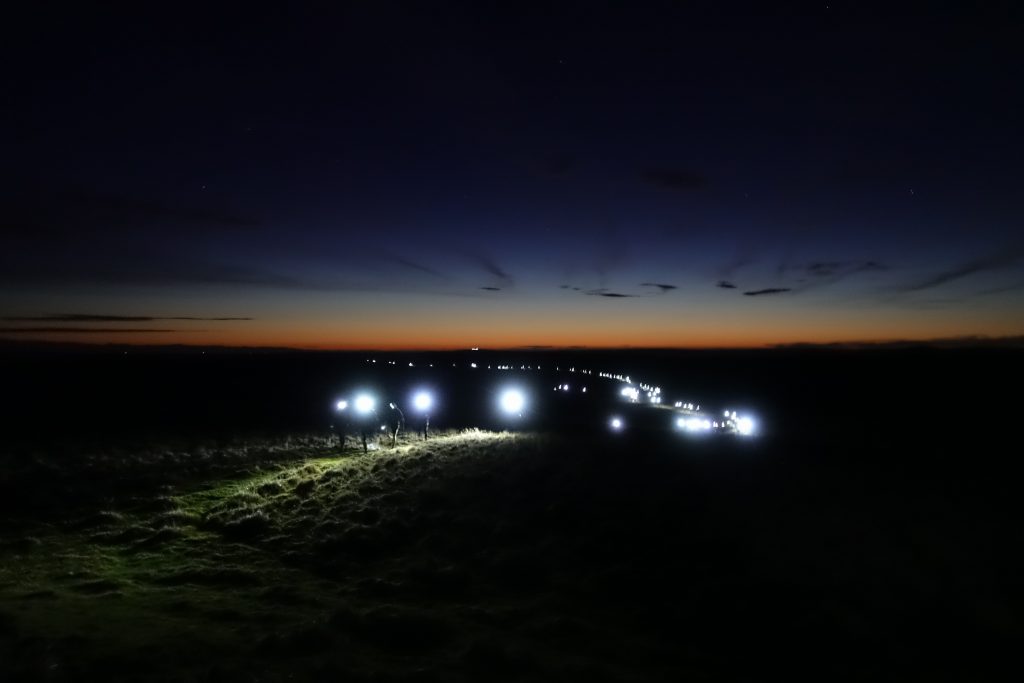
Soon after that, the bogs began. I found the best strategy was to read the ground and then jump at the right moment, clearing the worst and hoping the landing was reasonably solid. Most of the time this worked but I was knee deep on a few occasions. I heard some runners went up to their waists…
I’d spent a long time thinking about my clothing and kit choices for the race. It’s long and remote enough that if I wasn’t able to keep warm I’d quickly get into trouble and any kit malfunctions or discomforts would probably mean retirement. Pre-warned about the bogs and muddy terrain I wore Inov-8 Mudclaw shoes teamed with thin Smartwool liner socks and long Sealskinz waterproof socks. In deep mud these are the grippiest shoes I’ve ever tried and the combination worked brilliantly. I was amazed to find I still had dry feet at half way.
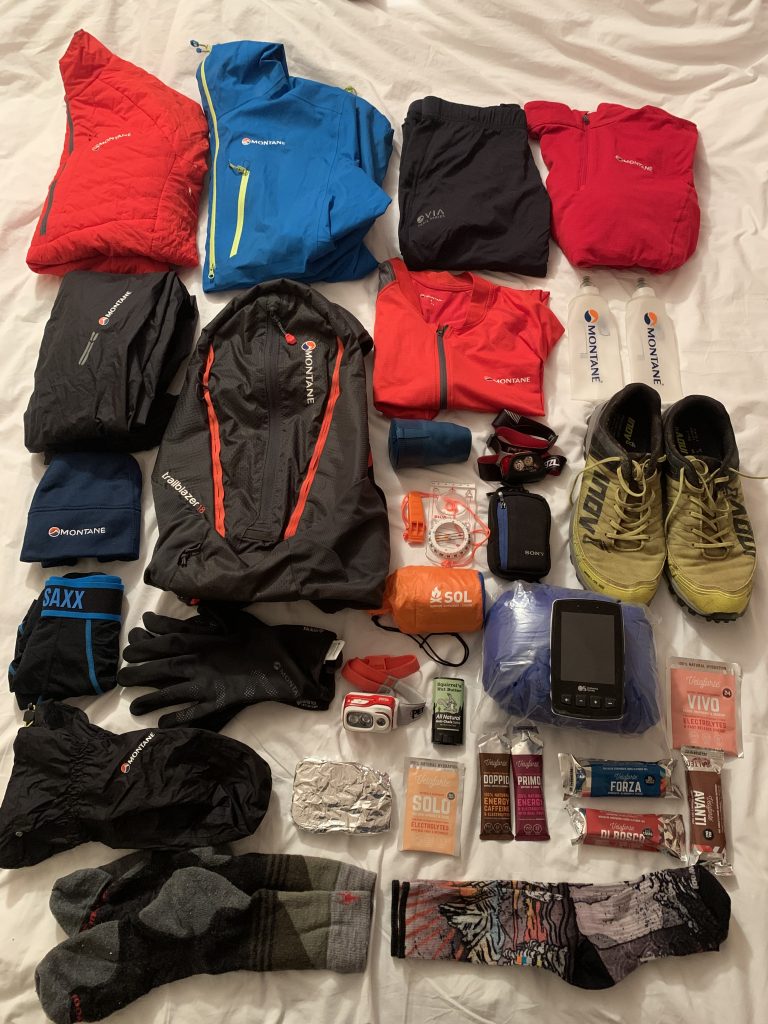
I started the race wearing the new Petzl Swift RL head torch, which easily provided enough light until the sun came up for a tiny 100g of extra pack weight.
We finally left the boggy section behind and, passing some cheery mountain rescue volunteers, reached the stone-flagged trail up to the summit of The Cheviot. This is the highest point in the National Park at 815 metres, but sadly when I arrived the top was shrouded in thick mist so I didn’t get to enjoy the views. The race follows an out-and-back route to the summit giving you a nice opportunity to briefly meet a few fellow runners as you try to pass on a person-wide flag stone without either of you falling into a bog.
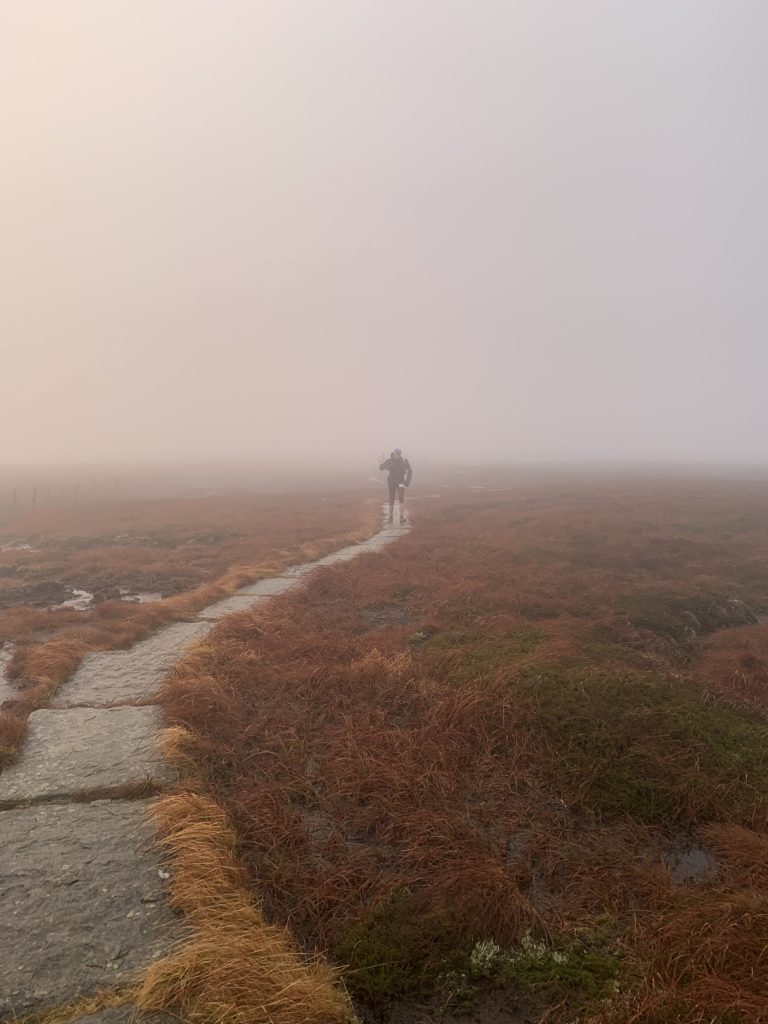
The next section followed the Pennine Way along a wet and exposed ridgeline. Running in this direction this was generally downhill, although there were a few uphill bits that I walked, using the slower pace as an opportunity to eat. The flagstones that pave most of the way were slippery and often submerged in muddy water leading to a most entertaining game of “will my foot land on a stone, slip sideways unpredictably or maybe there won’t be a stone at all and I’ll be knee deep” – perfect for keeping my by now tiring mind and legs occupied. However frustrating at that moment, the flags were an infinitely better option than the muddy bog swimming and erosion that would have happened in their absence.

Using the race as an opportunity to properly test out Montane’s range of winter running clothing, I raced in the VIA Trail Series Thermal Tights which kept my legs warm and protected. The wind-resistant thigh panels were very much appreciated, although I think a couple of stretch leg pockets would be a good addition. On my top half I wore a Fang Zip T and an Allez Micro fleece – a good combination allowing venting through the zips and keeping me comfortable under my jackets. I started out wearing the really excellent Fireball Verso Pull-On. It’s such a versatile insulation layer providing enough wind- and weather-proofing to cope with really bad conditions and a small amount of Primaloft insulation, which I always find to be just enough to keep me warm when running. This setup plus a hat and buff allowed me to vary my temperature to the race conditions really well.
I carried everything in the new Montane Trailblazer 18 which was comfortable and light. With plenty of pockets that are reachable on the go, I only had to take it off when I changed jackets in the evening and at the half-way point.
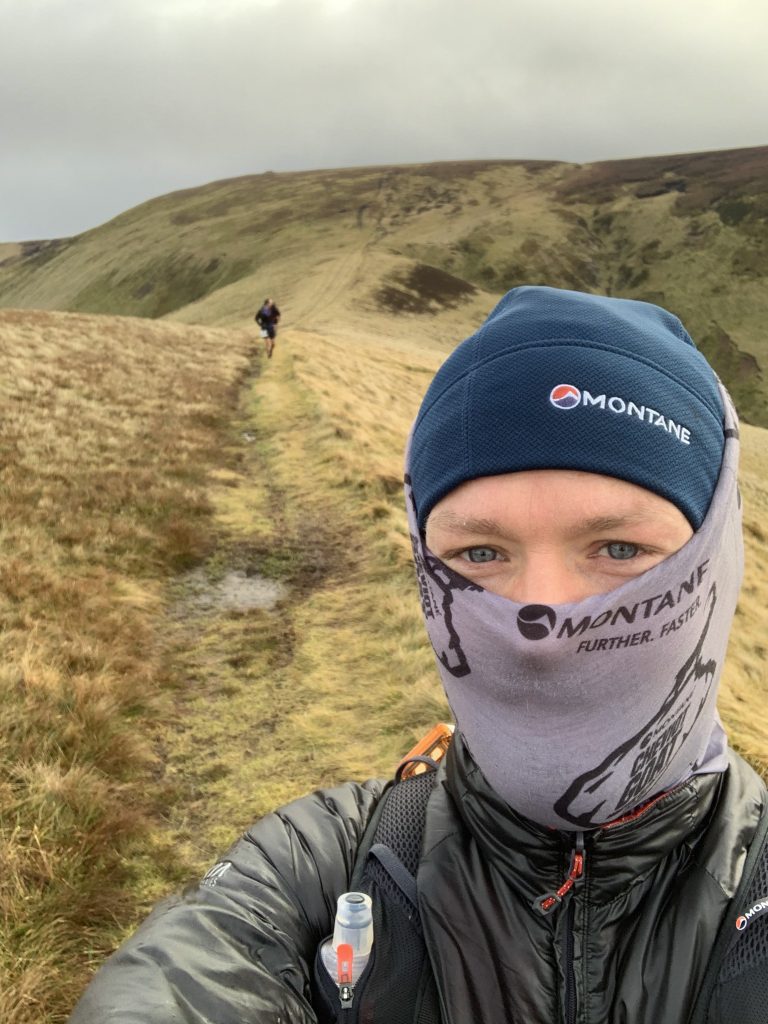
Cresting Deel’s Hill after about 40km I was surprised to see a road to the right; the area is so remote that this was an uncommon sight. It’s really the first place on the route that an extraction of a tired or injured runner would be reasonably straightforward. It’s a tough race to run but it’s also a huge challenge for the marshalls and the North of Tyne Mountain Rescue team who selflessly give their time to keep the runners safe, so a massive thanks to them all.
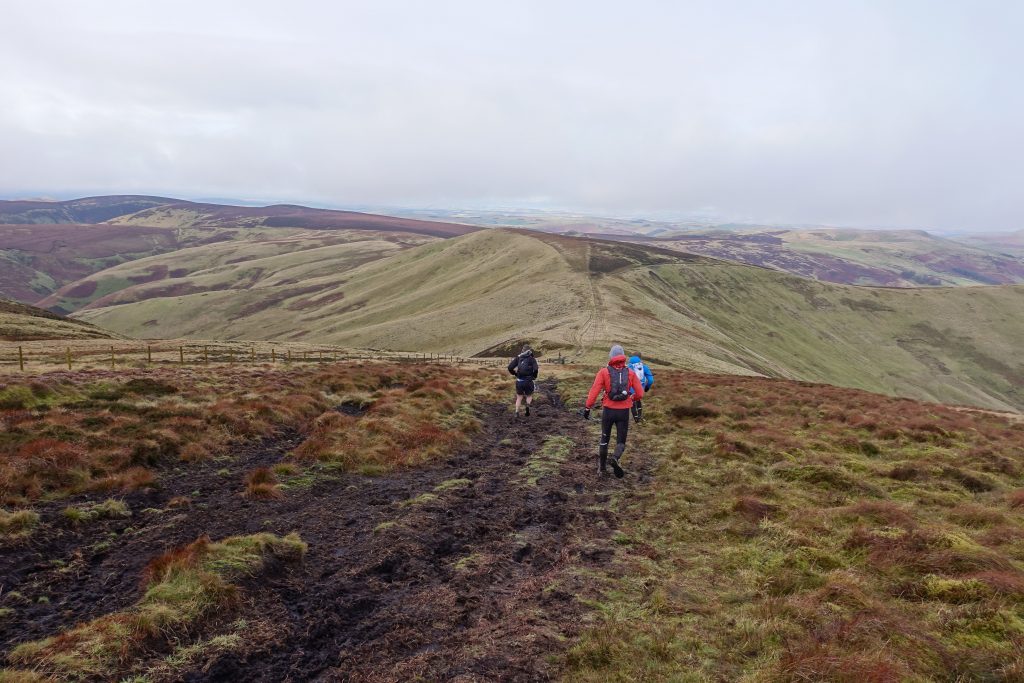
At the bottom of the hill the route headed left onto the road and followed it for a couple of miles. I was amazed how hard it felt to keep up any sort of pace; my legs didn’t like it and my feet protested against the hard surface. Thoughts of easy training runs teased me as I jogged along but I consoled myself with the easy miles and the half-way point now being well within reach. It was a huge relief to reach Barrowburn Farm, the only real aid station on the route, and where food, shelter and a fire awaited.
I’d considered writing myself a list of things to do at the half-way point, wondering how coherent I’d be or whether the warm fire and comfy seats might tempt me to stay for ever. I didn’t write one in the end, deciding I would concentrate on what I had to do on the run in and hopefully that would give me the required focus and momentum to get me back out.
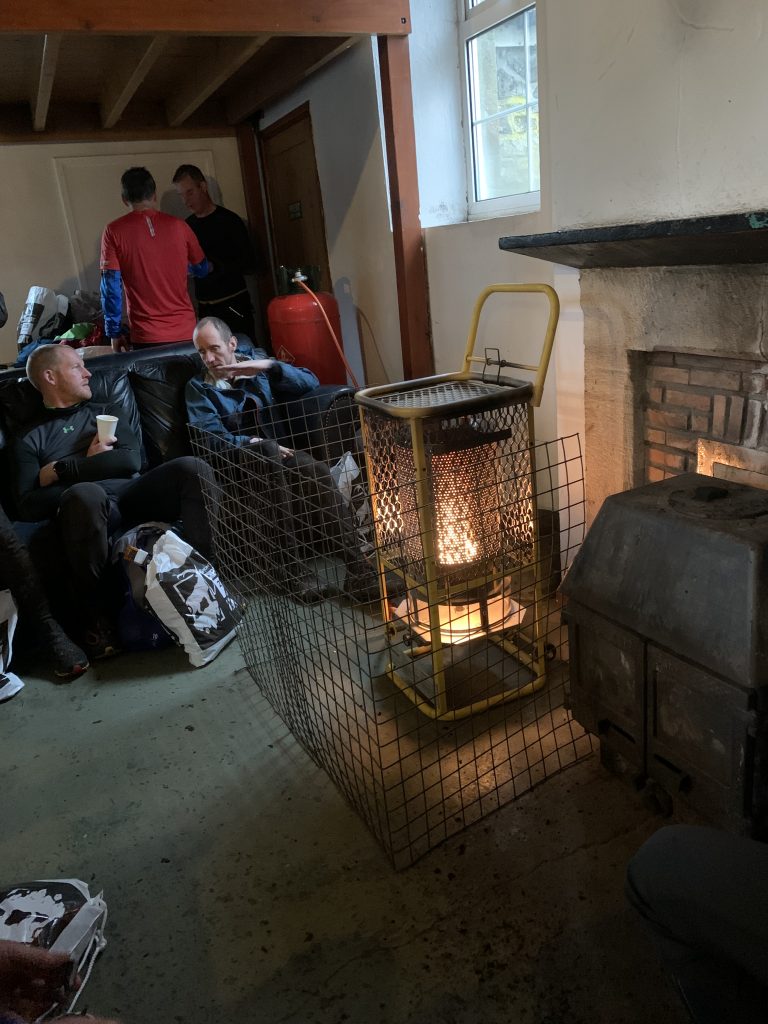
My plan was: 1. Get soup and tea. 2. Plug GPS and phone into my power bank. 3. Take off wet shoes and socks. 4. Remove rubbish from my pack and top up food and water supplies. 5. Swap head torches. 6. Drink soup and tea. 7. Apply foot lube (Squirrel’s Nut Butter). 8. Put on dry shoes and socks. 9. Go….
I’d decided to change shoes at half-way and knowing the terrain would be less boggy on the second half (which would usually be the first half) I swapped my caked Mudclaws for Salomon Speedcross 5 shoes and new socks. I like the latest update of the Speedcross – it’s a bit wider than the previous version, grippy on most surfaces and has more cushioning than the Mudclaws. In hindsight I think this was a good move as I really appreciated the extra cushioning and also just because the shoes are different. I happily finished the race with no blisters or foot problems at all.
The second half of the race felt totally different from the first. After about 30 miles we’d spread apart so I needed to navigate and was often running on my own with no other runners in sight. I loved the exposure and the remoteness, revelling in the navigation and exploration of such a wild area.
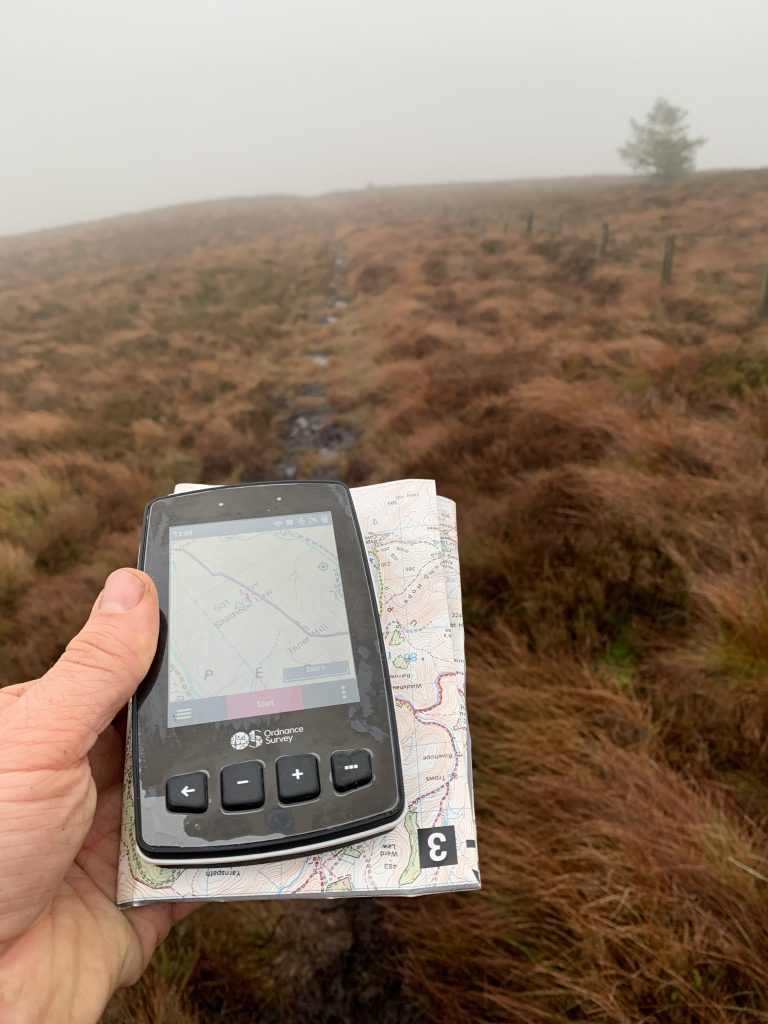
I hadn’t been able to recce any of the route, so other than a short section I’d previously run around the Cheviot the whole route was new to me. This was one of the reasons I wanted to do this race as running in new areas is a big motivation for me. But I also wanted to make the navigation as easy for myself as possible – and really didn’t want to be adding extra miles – so I borrowed a new Ordnance Survey Trail 2 GPS unit. I uploaded the route and the 20-hour battery life meant I could keep it on constantly and check where I was in relation to the route at the press of a button. Combining this with the map made navigation fairly easy, even in the dark crossing featureless grouse moor. I noticed that most racers had a GPS watch or handheld to guide them and I’d definitely recommend it.
At this point, somewhere after the half-way station I’d been on the go for about 9 hours. I’d hoped to finish in about 15 hours so I’d planned my food to match that plus some emergency rations just in case. On long races I try to eat something every 30 minutes and drink water straight after the food and this worked well for me again. I carry a mixture of food including chocolate, mini scotch eggs, energy bars and a slice of my mum’s Christmas cake – the icing/marzipan mix was particularly good 🙂 I’ve also been trying the new range of Veloforte energy bars, gels and electrolyte drinks which were a real win. If an energy bar contains all-natural ingredients and makes you excited after 12+ hours of running it has my vote! The Avanti with added sea salt is especially good.

The route in the second half followed a series of steep ascents onto long undulating ridgelines followed by big descents into the valleys. This continued until it started to get dark and, as I started up towards the superbly named Bloodybush Edge, it also started to rain. I stopped and swapped my Fireball for my full waterproof jacket – the bombproof Montane Spine pull-on (they no longer make this but it’s quite similar to the new Fleet jacket). I also retrieved my Petzl Nao+ head torch that I’d collected fully charged from my drop bag ready for the approaching darkness.

The bogs started again but now I found my tired legs could no longer jump quite far enough to clear them. For me this was by far the hardest section of the race. My pace was slow and I relied on my GPS much more than at any other point. My hands got cold and, letting my self-management slip, I didn’t put my gloves on. By the time I finally admitted I needed them my hands were numb, wet and swollen and I couldn’t get my Gore Infinium VIA Groove Gloves that had worked so well in at the start on. Thankfully, I also had a pair of super light, waterproof Minimus Mitts that I could wear and they kept my hands just about functioning. It was a good lesson in taking action before things become a problem; useless hands make it much harder to eat, drink and navigate, and in this kind of race can easily be the cause of a DNF.
It seemed to take forever to get to the summit of Bloodybush Edge but it felt great to meet the Mountain Rescue guys at the top. They were cheery and encouraging despite standing in driving rain and sub-zero conditions for I don’t know how long and they directed me down the hill to a most welcome track.
The last 10 miles mainly followed the old Salter’s Road and are considered a warm-up when the route goes in the usual direction. The navigation is easier and the running’s a bit faster on the easier terrain. I definitely appreciated the extra cushioning the Salomons gave me. I managed to get a bit lost, following the wrong wall near South Pike and it took a bit of bog wading to get back on the track. I almost trod on a pheasant!
Turning left onto the tractor track onto Leafield Edge about 4 miles from the finish really raised my spirits. I found that I could still run at a reasonable pace and I had my eye on a sub 14-hour finish. I really enjoyed the last couple of miles almost racing down the final hill towards Ingram.

I finished in 13:49:42 as 35th chap, very pleased but totally incapable of eating any of the soup provided by the brilliant folk at the Ingram cafe – sorry.
Entries are open for next year and I’d highly recommend it!